catalogue
Brute force cracking: an attack that attempts to obtain a user's password by using a large number of guesses and exhaustive methods. Just guess the password. The attacker keeps enumerating requests. By comparing the length of the data packet, you can well judge whether the blasting is successful or not. Because the length of the blasting success and failure is different, you can well judge whether the blasting is successful or not.
Low
Source code:
<?php
if( isset( $_GET[ 'Login' ] ) ) {
// Get username
$user = $_GET[ 'username' ];
// Get password
$pass = $_GET[ 'password' ];
$pass = md5( $pass );
// Check the database
$query = "SELECT * FROM `users` WHERE user = '$user' AND password = '$pass';";
$result = mysqli_query($GLOBALS["___mysqli_ston"], $query ) or die( '<pre>' . ((is_object($GLOBALS["___mysqli_ston"])) ? mysqli_error($GLOBALS["___mysqli_ston"]) : (($___mysqli_res = mysqli_connect_error()) ? $___mysqli_res : false)) . '</pre>' );
if( $result && mysqli_num_rows( $result ) == 1 ) {
// Get users details
$row = mysqli_fetch_assoc( $result );
$avatar = $row["avatar"];
// Login successful
$html .= "<p>Welcome to the password protected area {$user}</p>";
$html .= "<img src=\"{$avatar}\" />";
}
else {
// Login failed
$html .= "<pre><br />Username and/or password incorrect.</pre>";
}
((is_null($___mysqli_res = mysqli_close($GLOBALS["___mysqli_ston"]))) ? false : $___mysqli_res);
}
?>
It can be seen from the source code of the low level checkpoint that it obtains the user name and password entered by the user, and then encrypts the password with MD5, which eliminates the possibility of SQL injection through the password, and then queries the database to determine whether the user name and password entered by the user are correct according to the query results; However, it can be seen from the source code that it does not filter and check the entered user name and password. Here, you can use burp suite for simple brute force cracking:
Enter the user name admin and password, click login, and use burp suite to capture packets:
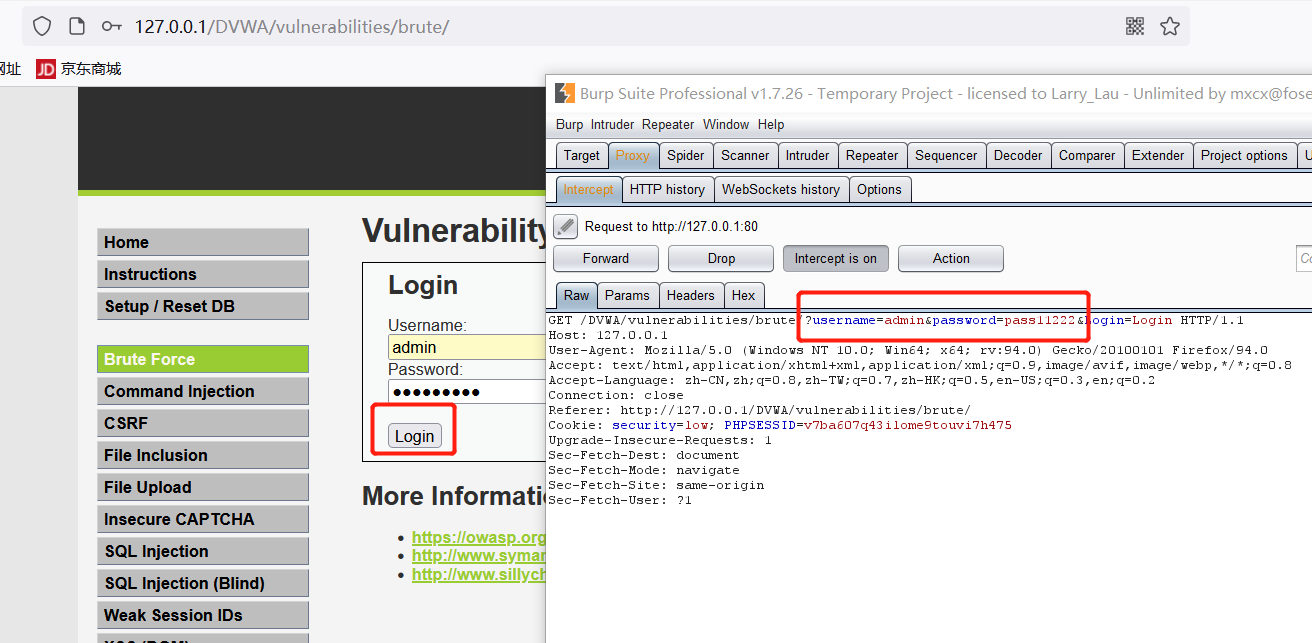
Send the data packet to the intruder module and brute force crack the password separately:
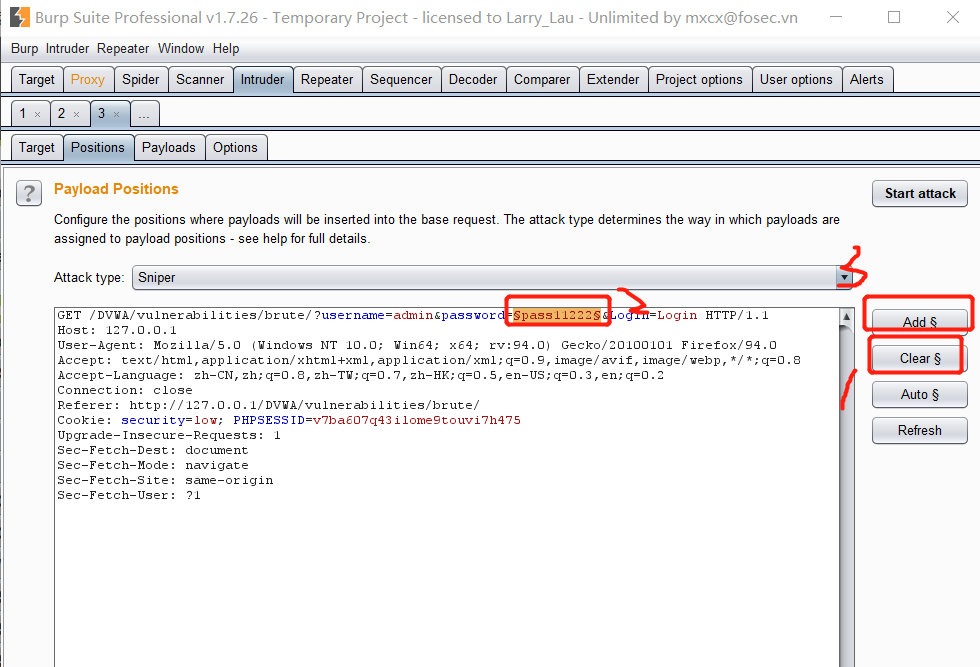

Use load to select the local blasting dictionary, and click start attack to attack;
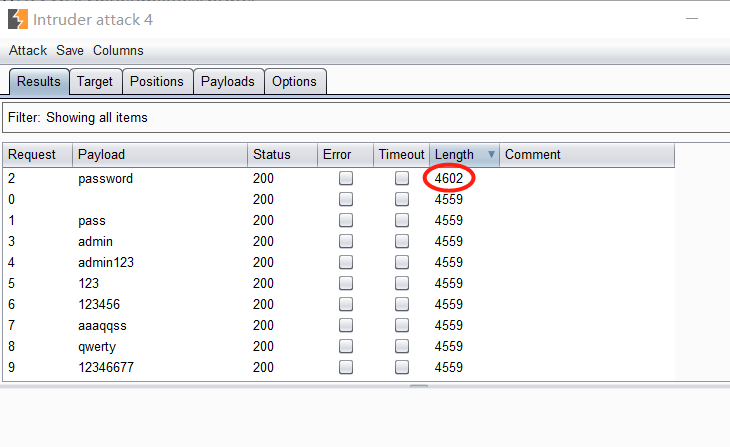
Finally, judge the password by the length, and crack the password as password.
Medium
Source code:
<?php
if( isset( $_GET[ 'Login' ] ) ) {
// Sanitise username input
$user = $_GET[ 'username' ];
$user = ((isset($GLOBALS["___mysqli_ston"]) && is_object($GLOBALS["___mysqli_ston"])) ? mysqli_real_escape_string($GLOBALS["___mysqli_ston"], $user ) : ((trigger_error("[MySQLConverterToo] Fix the mysql_escape_string() call! This code does not work.", E_USER_ERROR)) ? "" : ""));
// Sanitise password input
$pass = $_GET[ 'password' ];
$pass = ((isset($GLOBALS["___mysqli_ston"]) && is_object($GLOBALS["___mysqli_ston"])) ? mysqli_real_escape_string($GLOBALS["___mysqli_ston"], $pass ) : ((trigger_error("[MySQLConverterToo] Fix the mysql_escape_string() call! This code does not work.", E_USER_ERROR)) ? "" : ""));
$pass = md5( $pass );
// Check the database
$query = "SELECT * FROM `users` WHERE user = '$user' AND password = '$pass';";
$result = mysqli_query($GLOBALS["___mysqli_ston"], $query ) or die( '<pre>' . ((is_object($GLOBALS["___mysqli_ston"])) ? mysqli_error($GLOBALS["___mysqli_ston"]) : (($___mysqli_res = mysqli_connect_error()) ? $___mysqli_res : false)) . '</pre>' );
if( $result && mysqli_num_rows( $result ) == 1 ) {
// Get users details
$row = mysqli_fetch_assoc( $result );
$avatar = $row["avatar"];
// Login successful
$html .= "<p>Welcome to the password protected area {$user}</p>";
$html .= "<img src=\"{$avatar}\" />";
}
else {
// Login failed
sleep( 2 );
$html .= "<pre><br />Username and/or password incorrect.</pre>";
}
((is_null($___mysqli_res = mysqli_close($GLOBALS["___mysqli_ston"]))) ? false : $___mysqli_res);
}
?>
Compared with the LOW level, this level adds the verification of user input parameters, mysqli_ real_ escape_ The string function will escape characters to prevent sql injection; However, there is still no restriction and protection against brute force cracking, so you can also use burp suite to brute force crack it, but sleep (2) will be performed every time the password is wrong, sleep for two seconds, the speed of brute force cracking will be reduced, and the result can still be cracked.
High
Source code:
<?php
if( isset( $_GET[ 'Login' ] ) ) {
// Check Anti-CSRF token
checkToken( $_REQUEST[ 'user_token' ], $_SESSION[ 'session_token' ], 'index.php' );
// Sanitise username input
$user = $_GET[ 'username' ];
$user = stripslashes( $user );
$user = ((isset($GLOBALS["___mysqli_ston"]) && is_object($GLOBALS["___mysqli_ston"])) ? mysqli_real_escape_string($GLOBALS["___mysqli_ston"], $user ) : ((trigger_error("[MySQLConverterToo] Fix the mysql_escape_string() call! This code does not work.", E_USER_ERROR)) ? "" : ""));
// Sanitise password input
$pass = $_GET[ 'password' ];
$pass = stripslashes( $pass );
$pass = ((isset($GLOBALS["___mysqli_ston"]) && is_object($GLOBALS["___mysqli_ston"])) ? mysqli_real_escape_string($GLOBALS["___mysqli_ston"], $pass ) : ((trigger_error("[MySQLConverterToo] Fix the mysql_escape_string() call! This code does not work.", E_USER_ERROR)) ? "" : ""));
$pass = md5( $pass );
// Check database
$query = "SELECT * FROM `users` WHERE user = '$user' AND password = '$pass';";
$result = mysqli_query($GLOBALS["___mysqli_ston"], $query ) or die( '<pre>' . ((is_object($GLOBALS["___mysqli_ston"])) ? mysqli_error($GLOBALS["___mysqli_ston"]) : (($___mysqli_res = mysqli_connect_error()) ? $___mysqli_res : false)) . '</pre>' );
if( $result && mysqli_num_rows( $result ) == 1 ) {
// Get users details
$row = mysqli_fetch_assoc( $result );
$avatar = $row["avatar"];
// Login successful
$html .= "<p>Welcome to the password protected area {$user}</p>";
$html .= "<img src=\"{$avatar}\" />";
}
else {
// Login failed
sleep( rand( 0, 3 ) );
$html .= "<pre><br />Username and/or password incorrect.</pre>";
}
((is_null($___mysqli_res = mysqli_close($GLOBALS["___mysqli_ston"]))) ? false : $___mysqli_res);
}
// Generate Anti-CSRF token
generateSessionToken();
?>
Stripsplashes function: remove the backslash of string characters; mysqli_real_escape_string: escape characters.
Compared with the previous level, anti CSRF is added to this level Token to resist CSRF attacks. Due to the use of anti CSRF token, a random user will be included in the login page returned by the server every time_ The value of token. Each time a user logs in, the user_ Submit together with token. After receiving the request, the server will first check the token and then perform sql query.
Here, you need to simulate the browser to send a request to the server, then obtain the token, and then use the obtained token to explode. The token obtained is different each time.
1. Capture packets, send them to Intruder module, select pitchfork (pitchfork mode), and add blasting parameters:
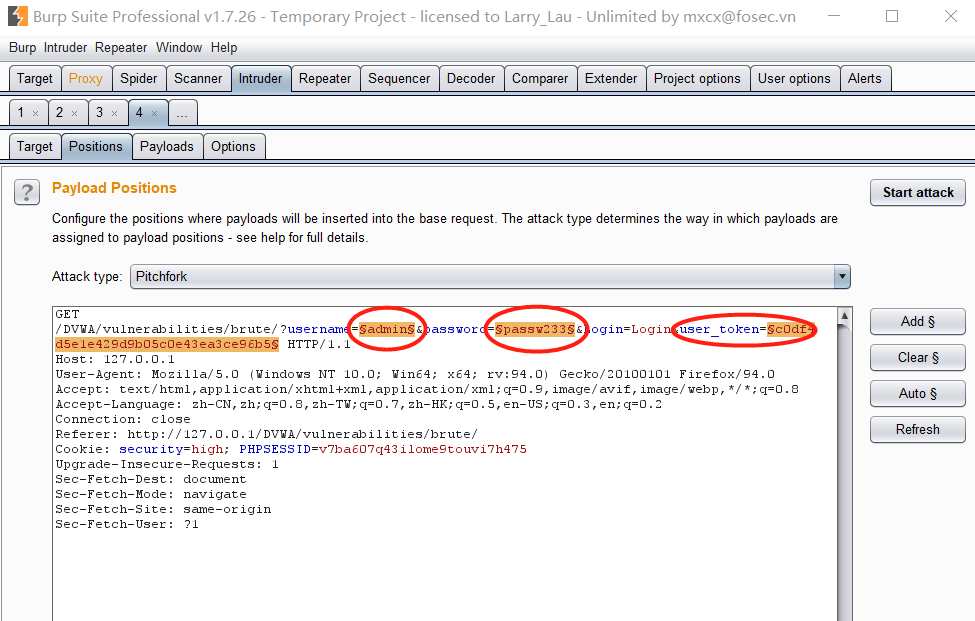
2. Find the Request Engine module in Options, set the number of threads to 1, find the redactions module, and select always to allow redirection:
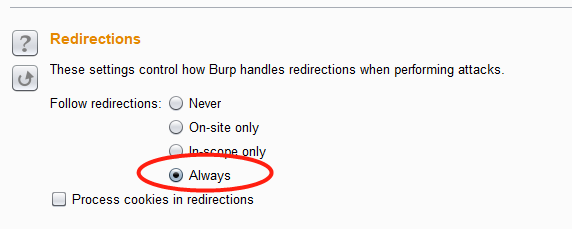
3. Find the grep extract module in Options, click Add, and set the filter criteria to get user_ The value value of token and save the value value:
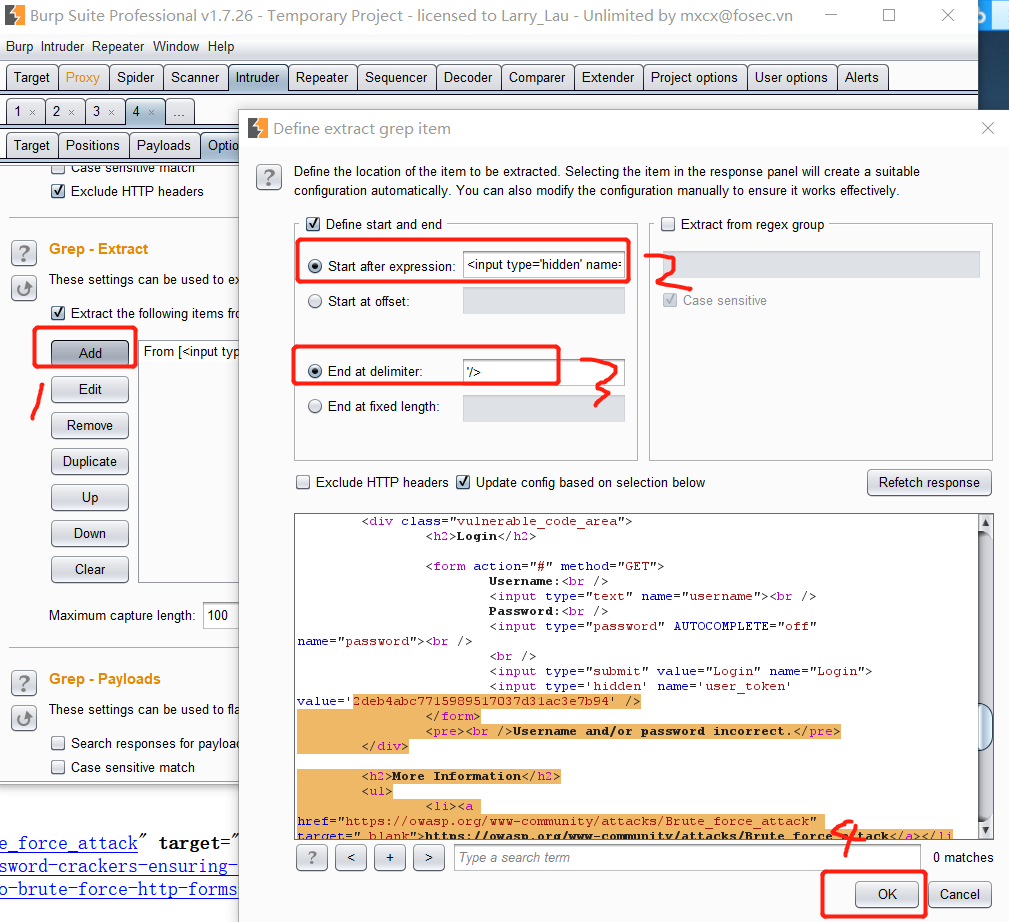
4. Set the dictionary for the selected parameters in Payloads:
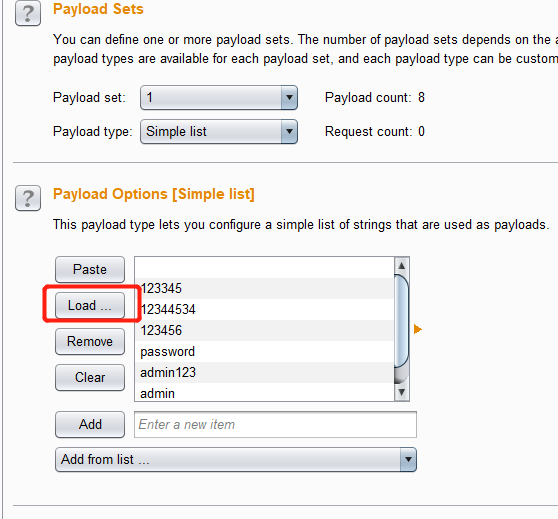
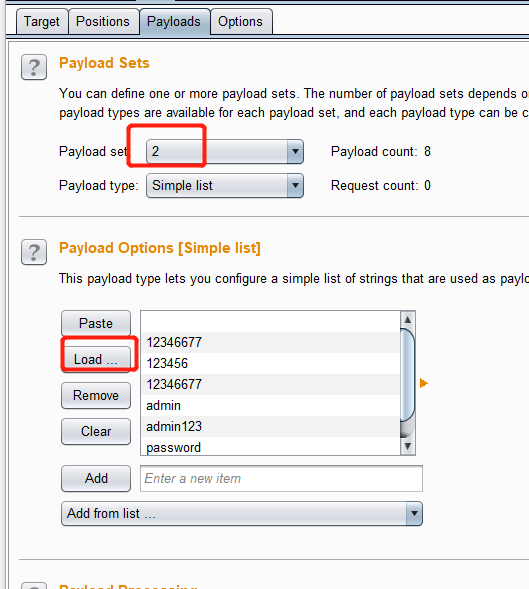
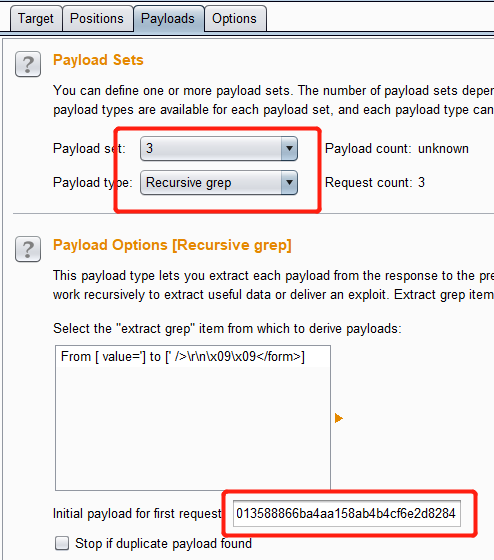
5. Click start attack to start blasting
 Got the final account and password.
Got the final account and password.
The process is a little complicated, so we need to refer to the practices of the great gods.
Here are two references:
First, use burp suite to configure blasting parameters and conduct blasting: DVWA brute force cracking (high security level)_ Unspeakable blog - CSDN blog
The second is to use python script for blasting: DVWA-1.3 Brute Force - High - bypass token - zhengna - blog Park
Impossible
Source code:
<?php
if( isset( $_POST[ 'Login' ] ) && isset ($_POST['username']) && isset ($_POST['password']) ) {
// Check Anti-CSRF token
checkToken( $_REQUEST[ 'user_token' ], $_SESSION[ 'session_token' ], 'index.php' );
// Sanitise username input
$user = $_POST[ 'username' ];
$user = stripslashes( $user );
$user = ((isset($GLOBALS["___mysqli_ston"]) && is_object($GLOBALS["___mysqli_ston"])) ? mysqli_real_escape_string($GLOBALS["___mysqli_ston"], $user ) : ((trigger_error("[MySQLConverterToo] Fix the mysql_escape_string() call! This code does not work.", E_USER_ERROR)) ? "" : ""));
// Sanitise password input
$pass = $_POST[ 'password' ];
$pass = stripslashes( $pass );
$pass = ((isset($GLOBALS["___mysqli_ston"]) && is_object($GLOBALS["___mysqli_ston"])) ? mysqli_real_escape_string($GLOBALS["___mysqli_ston"], $pass ) : ((trigger_error("[MySQLConverterToo] Fix the mysql_escape_string() call! This code does not work.", E_USER_ERROR)) ? "" : ""));
$pass = md5( $pass );
// Default values
$total_failed_login = 3;
$lockout_time = 15;
$account_locked = false;
// Check the database (Check user information)
$data = $db->prepare( 'SELECT failed_login, last_login FROM users WHERE user = (:user) LIMIT 1;' );
$data->bindParam( ':user', $user, PDO::PARAM_STR );
$data->execute();
$row = $data->fetch();
// Check to see if the user has been locked out.
if( ( $data->rowCount() == 1 ) && ( $row[ 'failed_login' ] >= $total_failed_login ) ) {
// User locked out. Note, using this method would allow for user enumeration!
//$html .= "<pre><br />This account has been locked due to too many incorrect logins.</pre>";
// Calculate when the user would be allowed to login again
$last_login = strtotime( $row[ 'last_login' ] );
$timeout = $last_login + ($lockout_time * 60);
$timenow = time();
/*
print "The last login was: " . date ("h:i:s", $last_login) . "<br />";
print "The timenow is: " . date ("h:i:s", $timenow) . "<br />";
print "The timeout is: " . date ("h:i:s", $timeout) . "<br />";
*/
// Check to see if enough time has passed, if it hasn't locked the account
if( $timenow < $timeout ) {
$account_locked = true;
// print "The account is locked<br />";
}
}
// Check the database (if username matches the password)
$data = $db->prepare( 'SELECT * FROM users WHERE user = (:user) AND password = (:password) LIMIT 1;' );
$data->bindParam( ':user', $user, PDO::PARAM_STR);
$data->bindParam( ':password', $pass, PDO::PARAM_STR );
$data->execute();
$row = $data->fetch();
// If its a valid login...
if( ( $data->rowCount() == 1 ) && ( $account_locked == false ) ) {
// Get users details
$avatar = $row[ 'avatar' ];
$failed_login = $row[ 'failed_login' ];
$last_login = $row[ 'last_login' ];
// Login successful
$html .= "<p>Welcome to the password protected area <em>{$user}</em></p>";
$html .= "<img src=\"{$avatar}\" />";
// Had the account been locked out since last login?
if( $failed_login >= $total_failed_login ) {
$html .= "<p><em>Warning</em>: Someone might of been brute forcing your account.</p>";
$html .= "<p>Number of login attempts: <em>{$failed_login}</em>.<br />Last login attempt was at: <em>${last_login}</em>.</p>";
}
// Reset bad login count
$data = $db->prepare( 'UPDATE users SET failed_login = "0" WHERE user = (:user) LIMIT 1;' );
$data->bindParam( ':user', $user, PDO::PARAM_STR );
$data->execute();
} else {
// Login failed
sleep( rand( 2, 4 ) );
// Give the user some feedback
$html .= "<pre><br />Username and/or password incorrect.<br /><br/>Alternative, the account has been locked because of too many failed logins.<br />If this is the case, <em>please try again in {$lockout_time} minutes</em>.</pre>";
// Update bad login count
$data = $db->prepare( 'UPDATE users SET failed_login = (failed_login + 1) WHERE user = (:user) LIMIT 1;' );
$data->bindParam( ':user', $user, PDO::PARAM_STR );
$data->execute();
}
// Set the last login time
$data = $db->prepare( 'UPDATE users SET last_login = now() WHERE user = (:user) LIMIT 1;' );
$data->bindParam( ':user', $user, PDO::PARAM_STR );
$data->execute();
}
// Generate Anti-CSRF token
generateSessionToken();
?>
It can be seen from the source code that this level is different from other difficulty levels. The impossibility level limits the number of user logins on the basis of high. When the user fails to log in for 3 times, the account will be locked for 15 seconds. At the same time, a more secure PDO (PHP Data Object) mechanism is used to prevent sql injection. Here, because PDO extension itself cannot be used to perform any database operations, The key of sql injection is to execute malicious sql commands by destroying the structure of sql statements, which can not be cracked